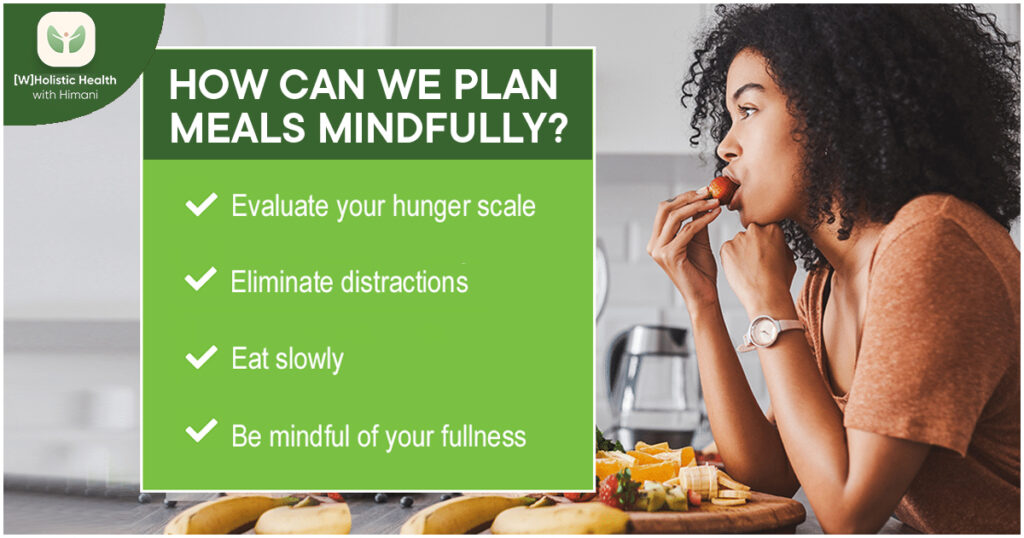In our fast-paced world, eating has often become mindless while working, watching TV, or scrolling through our phones. Mindful eating offers a different approach, transforming our relationship with food and nourishment. At its core, mindful eating brings consciousness to how we eat, not just about feeding our bodies but nurturing our overall well-being.
Table of Contents
ToggleHow Does Mindfulness Transform Our Relationship with Food?
The principles of mindful eating stem from ancient mindfulness practices adapted for our modern relationship with food. When we eat mindfully, we engage all our senses, becoming fully present in the moment. This practice creates a profound connection between our mental and physical well-being, as how we eat directly impacts our body and mind.
What’s the Difference Between Mindful and Mindless Eating?
Consider the difference between mindful and mindless eating. When eating mindlessly, we might finish a meal without tasting it, often consuming more than our bodies need. In contrast, mindful eating allows us to experience each bite fully, leading to greater satisfaction and better nutrition. Being present during meals isn’t just about focusing on your food—it’s about understanding your body’s needs and responses.
How Can We Better Listen to Our Body’s Signals?
Our bodies constantly communicate with us, sending signals about hunger, fullness, and nutritional needs. Learning to interpret these signals is a crucial aspect of mindful eating. True hunger typically develops gradually and is accompanied by physical sensations like a growling stomach or light-headedness. However, external factors often override these natural cues in our modern environment.
How Can We Tell the Difference Between Emotional and Physical Hunger?
Understanding the difference between emotional and physical hunger is vital. Physical hunger develops gradually and can be satisfied with various foods, while emotional hunger often comes on suddenly and craves specific comfort foods. By tuning into your body’s needs, you can better distinguish between these different types of hunger and respond appropriately.
Read More: Why Is Balanced Nutrition Essential for Optimal Health?
Learning to honor your body’s satiety cues takes practice. It means eating until you’re comfortably satisfied rather than overly full. External factors like stress, time constraints, and social pressure can make it challenging to recognize these signals. Still, you can develop a stronger connection to your body’s natural wisdom with practice.
How Can We Master Portion Control Without Strict Rules?
Portion control in mindful eating isn’t about strict measurements or calorie counting. Instead, it’s about understanding what your body needs and responding accordingly. The concept of portion sizes has become distorted in modern society, with restaurant servings often far exceeding what our bodies require.
Rather than viewing portion control as a restrictive practice, mindful eating encourages you to consider it a form of self-care. Eating the right amount for your body makes you feel energized rather than sluggish. This approach naturally prevents overheating without the need for strict rules or measurements.
The key is finding balance. Restrictive diets often lead to a cycle of deprivation and overindulgence. Mindful eating allows for moderation and flexibility, making room for nutritious foods and occasional treats. This balanced approach creates a sustainable relationship with food that can last a lifetime.
Why Does Eating Slowly Matter?
The simple act of slowing down while eating can profoundly impact your health and satisfaction with meals. When you eat slowly, your body has time to process food properly and signal when it’s had enough. This natural mechanism often gets interrupted when we rush through meals.
Read More: High Protein Soya Bean Kebab: A Nutritious Powerhouse
Eating slowly also enhances digestion. When you take time to chew thoroughly and eat at a relaxed pace, your digestive system can better break down food and absorb nutrients. This improved digestion often leads to better energy levels and fewer digestive issues.
Creating a peaceful eating environment supports slower eating habits. This might mean setting aside specific meal times, eating away from screens, or creating a pleasant atmosphere at your dining table. These environmental factors can significantly influence your eating pace and overall relationship with food.

How Can We Plan Meals Mindfully?
Thoughtful meal planning is a cornerstone of mindful eating. It’s not just about deciding what to eat—it’s about creating a framework that supports your health goals while remaining flexible enough to adapt to your changing needs. When you plan meals mindfully, you’re more likely to make choices that nourish both body and mind.
Planning meals doesn’t mean rigid scheduling. Instead, it involves creating a general framework that includes balanced, nutritious options while leaving room for spontaneity and enjoyment. This approach helps reduce stress around food choices while ensuring you have what you need to nourish yourself well.
Mindful grocery shopping is an essential part of meal planning. It involves choosing foods thoughtfully, reading labels when necessary, and selecting ingredients that will contribute to satisfying, nutritious meals. This thoughtful approach to shopping sets the foundation for mindful eating throughout the week.
How Does Food Affect Our Emotional Well-being?
The connection between emotions and eating is complex and deeply rooted. Many of us learn to use food to cope with emotions early on. While food can provide temporary comfort, understanding and managing emotional eating is crucial for long-term wellness.
Developing awareness of your emotional eating patterns is the first step toward change. This might involve keeping a journal to track your eating patterns and emotional states, which can help you identify triggers and develop alternative coping strategies. Remember that emotional eating isn’t a character flaw—it’s a learned behavior that can be changed with patience and practice.
Mindfulness provides tools for managing food cravings and emotional eating. By staying present with your emotions without judgment, you can learn to experience them without automatically turning to food for comfort. This practice builds emotional resilience and a healthier relationship with food.
How Does Food Nourish Both Body and Mind?
The food we eat profoundly affects our mental health and cognitive function. Nutrient-dense foods provide the building blocks for neurotransmitters that regulate mood, energy, and focus. Understanding this connection helps motivate mindful food choices supporting physical and mental well-being.
Mindful food preparation can be a meditation, bringing presence and intention to the cooking process. This mindful approach often leads to more enjoyable meals and a deeper appreciation for the nourishment food provides. Taking time to prepare meals mindfully can become a form of self-care and stress relief.
The mind-body connection in eating extends beyond just the nutrients we consume. Our thoughts and attitudes about food significantly impact how our bodies process and utilize our food. Cultivating positive, balanced thoughts about food and eating supports optimal nutrition and overall health.
How Can We Stay Mindful in Social Settings?
Maintaining mindful eating practices in professional and social environments presents unique challenges. Workplace stress, time constraints, and social pressure can make staying connected to mindful eating principles difficult. However, with preparation and practice, you can navigate these situations while staying true to your mindful eating goals.
Social gatherings often center around food, which can create anxiety for those working to maintain mindful eating habits. The key is finding balance—allowing yourself to enjoy special occasions while staying connected to your body’s needs. This might mean eating a small, nutritious meal before events or focusing on social connections rather than just the food.
What Role Does Mindful Eating Play in Weight Management?
Mindful eating offers a refreshing perspective on weight management. It focuses on sustainable habits rather than quick fixes or strict rules. This approach acknowledges that our bodies naturally maintain a healthy weight when we eat mindfully and honor our hunger and fullness cues.
The journey of weight management through mindful eating emphasizes self-acceptance and body positivity. Instead of fighting against your body, you learn to work with it, trusting its wisdom and natural regulatory mechanisms. This approach often leads to more sustainable results than traditional dieting methods.
How Can We Build a Lasting Mindful Eating Practice?
Developing a mindful eating practice is a journey, not a destination. It involves creating new habits and ways of thinking about food while letting go of old patterns that no longer serve you. Success comes from making small, consistent changes rather than trying to transform everything at once.
Remember that perfection isn’t the goal—progress is. There will be times when you eat mindlessly or make choices that don’t align with your intentions. These moments aren’t failures but opportunities to learn and grow in your mindful eating journey.
The power of mindful eating lies in its simplicity and sustainability. By bringing consciousness to how we nourish ourselves, we can develop a peaceful, balanced relationship with food that supports our overall well-being. This practice extends beyond meals to influence how we care for ourselves in all areas of life.
In conclusion, mindful eating offers a path to better health that doesn’t require strict rules or deprivation. Instead, it invites us to develop a more conscious, compassionate relationship with food and our bodies. Through this practice, we can find greater peace, satisfaction, and joy in nourishing ourselves.

I’m Himani, a Singapore-based health coach certified by IIN. I help clients create personalized nutrition and lifestyle plans that lead to lasting health goals. By focusing on individual needs, I provide actionable steps to support your journey to optimal well-being











